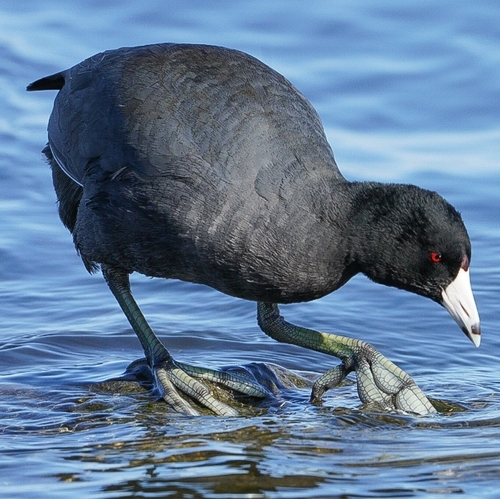
American Coot
The American Coot (Fulica americana) is a highly adaptable waterbird found throughout North and Central America. Often mistaken for a duck, it is actually a member of the rail family, characterized by its distinctive lobed toes rather than webbed feet. This species plays a vital role in wetland ecosystems, primarily consuming aquatic vegetation and invertebrates, thereby influencing nutrient cycling. While not holding major cultural significance in many areas, it's a common and easily recognizable bird, appreciated by birdwatchers for its unique appearance and behavior. Its adaptability has allowed it to thrive in a variety of wetland habitats, even those impacted by human activity.
34-43 cm
Length
58-71 cm
Wingspan
Least Concern
Conservation Status
Distribution
The American Coot breeds across a wide range of North America, from southern Canada through the United States and into Mexico and Central America. Some populations are migratory, moving south to the southern United States, Mexico, and the Caribbean for the winter. They are also found in parts of South America. The altitudinal range extends from sea level to high-altitude lakes in some regions.
Lifespan
Up to 9 years in the wild, although many individuals do not survive their first year. Captive individuals have been known to live longer.
American Coot's Habitat
Habitat Types
Freshwater marshes, Lakes, Ponds, Reservoirs, Slow-moving rivers, Brackish coastal wetlands
Climate Zones
Temperate, Subtropical, Tropical
Adaptations
American Coots possess lobed toes, which are an adaptation for swimming and walking on soft, muddy substrates. These lobes provide increased surface area for propulsion in water and prevent sinking in mud. They are also capable of diving to considerable depths to forage for food.
Variations
Several subspecies have been described, differing slightly in size and plumage coloration. These variations are often subtle and require expert examination for identification. For example, *Fulica americana columbiana* is found in parts of South America.
Appearance
Breeding Plumage
Plumage is generally consistent year-round, although breeding birds may have brighter frontal shields.
Seasonal Feather Changes
Minimal seasonal variation.
Sex Based Plumage Differences
Minimal; males and females have similar plumage.
Notable Features
Dark gray to black body plumage, White bill with a reddish-brown frontal shield, Red eyes, Lobed toes (not webbed), Short, rounded wings
Diet and Feeding
Primary Foods
Aquatic plants (e.g., algae, duckweed, pondweed), Seeds, Insects, Mollusks, Crustaceans, Small fish
Foraging Behavior
American Coots are versatile feeders, employing various techniques. They dabble at the surface, dive underwater, graze on land, and even steal food from other birds (kleptoparasitism). They often forage in flocks, particularly during the non-breeding season.
Specializations
Their lobed toes aid in diving and maneuvering underwater. The bill is adapted for both grasping vegetation and capturing small invertebrates.
Seasonal Diet Variations
Diet can shift depending on food availability. During the breeding season, they may consume more invertebrates to meet the protein demands of egg production and chick rearing. In winter, they may rely more heavily on plant matter.
Behavior
Social Structure
American Coots are highly social, especially outside the breeding season, when they often form large flocks. During the breeding season, they become more territorial.
Communication
A variety of calls, including grunts, croaks, and cackles, Visual displays, such as head bobbing and wing flapping, Splash displays during territorial disputes
Migration
Many populations are migratory, traveling long distances between breeding and wintering grounds. Migration is often triggered by changes in day length and temperature. They typically migrate at night.
Territorial or Group Behaviors
During the breeding season, pairs defend territories around their nests. Outside the breeding season, they are highly gregarious and form large flocks, sometimes numbering in the thousands. They exhibit aggressive behaviors, including chasing and pecking, to establish dominance within flocks.
Conservation
Threats
Habitat loss and degradation (wetland drainage), Pollution (pesticides, heavy metals), Lead poisoning (from ingestion of lead shot), Collisions with human structures (e.g., power lines), Climate change (altering wetland habitats)
Protection Programs
Wetland conservation and restoration efforts, Regulations on lead shot use in some areas, Monitoring of populations through bird surveys
Local National Laws
Protected under the Migratory Bird Treaty Act in the United States and similar legislation in other countries.
Population Trend
Stable
Population Estimates
The global population is estimated to be in the millions.
Interesting Facts
Coots are known for their aggressive behavior.
They will fiercely defend their territories and even engage in brood parasitism, laying their eggs in the nests of other coots and sometimes other bird species.
They are surprisingly strong fliers despite their short, rounded wings.
Migratory populations undertake long journeys, often flying at night.
American Coots have lobed toes instead of webbed feet.
This adaptation allows them to walk effectively on muddy surfaces and swim efficiently.
They are known for their 'running' takeoffs.
Due to their body weight and wing shape, they need a running start across the water to become airborne.
Faqs about American Coot
Are American Coots ducks?
No, American Coots are members of the rail family (Rallidae), not the duck family (Anatidae). They are more closely related to rails and gallinules.
What do American Coots eat?
They have a varied diet that includes aquatic plants, seeds, insects, mollusks, crustaceans, and small fish.
Where do American Coots live?
They inhabit freshwater marshes, lakes, ponds, reservoirs, and slow-moving rivers throughout North and Central America, and parts of South America.
Are American Coots endangered?
No, they are classified as 'Least Concern' by the IUCN, meaning they have a stable and widespread population.
Copyright @ Nature Style Limited. All Rights Reserved.
 English
English